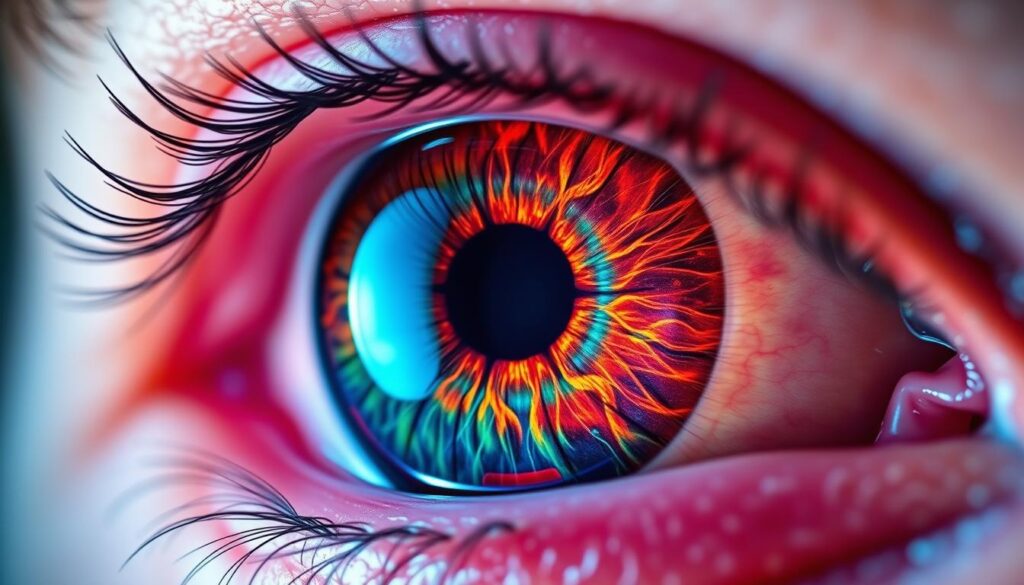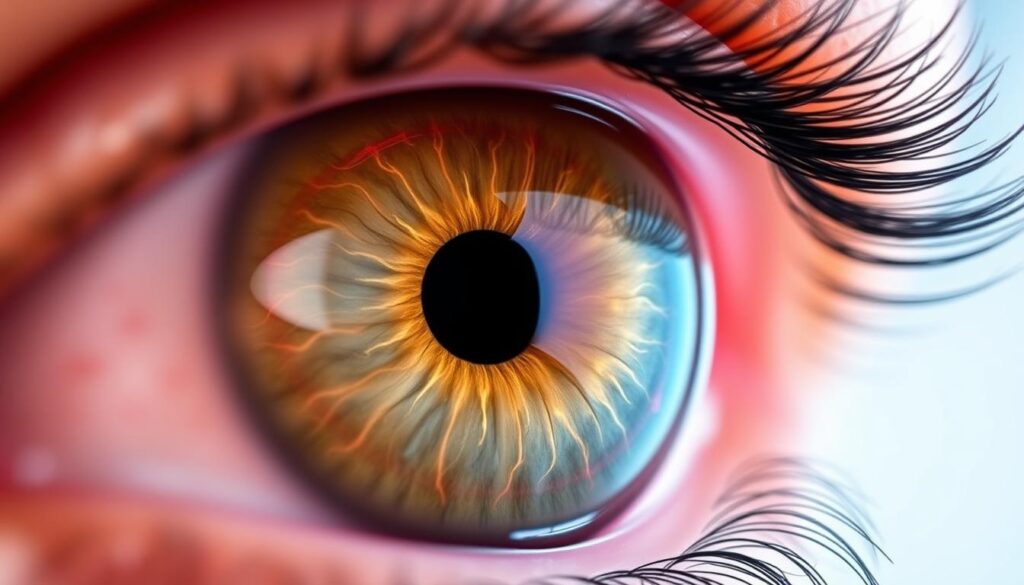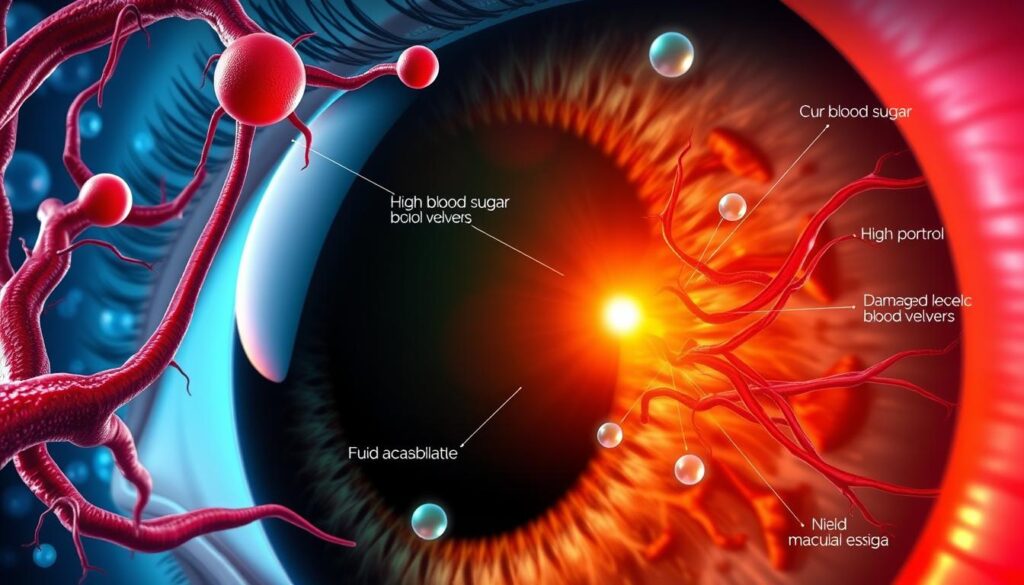Do you know how diabetic macular edema (DME) can hurt your vision? This eye problem often comes from diabetes and can make seeing clearly hard. It makes everyday tasks tough. But what is DME, and how can we manage it? Learning about it is key to keeping your eyesight.

Diabetic macular edema is a serious eye issue for people with diabetes, especially those with it for a long time. It happens when fluid builds up in the macula, the eye part for central vision. This swelling can cause blurry or distorted vision, making things like reading, driving, or seeing faces hard.
Knowing the causes and treatments for DME is important for those with diabetes. By being informed and taking action, you can prevent or manage this condition. This helps protect your vision and improves your life quality. So, let’s dive into the details of diabetic macular edema and find ways to treat and manage it.
What is Diabetic Macular Edema and Its Impact on Vision
Diabetic macular edema (DME) is a complication of diabetic retinopathy. It affects the small blood vessels in the retina. Fluid and protein deposits build up in the macula, causing swelling and thickening.
This makes it hard to see fine details. The macula is key for clear, sharp vision.
Understanding the Macula and Its Function
The macula is at the center of the retina. It’s responsible for our central vision. This lets us see fine details and colors clearly.
When the macula is affected by DME, daily activities get tough. Reading, driving, and recognizing faces become challenges.
How DME Affects Daily Vision
DME causes blurred and distorted central vision. It makes everyday tasks hard. Reading, watching TV, and recognizing faces become difficult.
In severe cases, DME can cause a loss of central vision. But peripheral vision usually stays the same.
Risk Factors and Prevention Strategies
Poor blood sugar control, high blood pressure, and high cholesterol increase DME risk. Regular eye exams and early intervention are key. They help manage diabetic retinopathy and prevent DME.
Living a healthy lifestyle also helps. Eating well and exercising regularly can lower DME risk.
Knowing about the macula and DME’s effects on vision is important. People with diabetes can take steps to protect their eyes. Regular eye exams and timely treatment are crucial.
Early Signs and Symptoms of Diabetic Macular Edema
Diabetic macular edema (DME) is a serious eye problem linked to diabetes. It often starts without clear signs. Spotting early symptoms is key to catching it early and saving your sight. Let’s look at the common signs of DME.
One early sign is blurry or distorted vision in the center. Straight lines might look wavy. Reading or doing close-up tasks can also get harder. This happens because fluid builds up in the macula, the part of the retina that helps us see details.
Seeing blind spots or dark areas in your vision is another symptom. These spots, known as diabetic macular edema icd-10 code E11.311, can make daily tasks tough, like driving or reading.
- Blurred or distorted central vision
- Wavy or bent appearance of straight lines
- Difficulty with reading and close-up tasks
- Blind spots or dark areas in the central field of vision
If you notice these signs, see an eye doctor right away. They can do a detailed eye check. Early treatment can help manage diabetic macular edema and keep your vision good.

“Early detection and treatment of diabetic macular edema can make a significant difference in preserving vision and quality of life for individuals with diabetes.”
| Symptom | Description |
|---|---|
| Blurred or distorted central vision | Gradual blurring or distortion of central vision due to fluid buildup in the macula |
| Wavy or bent appearance of straight lines | Straight lines appear wavy or bent, which can interfere with reading and close-up tasks |
| Blind spots or dark areas in central vision | Blind spots or dark areas in the central field of vision, which can be identified by the diabetic macular edema icd-10 code E11.311 |
Diagnosing DME: Medical Tests and Procedures
Diagnosing diabetic macular edema (DME) is key to managing this serious eye condition. Doctors use many tests and procedures to check for DME. Important tools include OCT scanning, fluorescein angiography, and visual acuity testing.
Optical Coherence Tomography (OCT) Scanning
OCT scanning is a non-invasive way to see the retina in detail. It helps doctors find diabetic macular edema oct by showing fluid and thickening in the retina.
Fluorescein Angiography
Fluorescein angiography is vital for diabetic macular edema ppt. It involves injecting dye into the blood to see the retina’s blood flow. Doctors use it to spot leaks or blockages that cause DME.
Visual Acuity Testing
Doctors also use visual acuity testing to check vision loss from DME. This test measures how well a person can see. It helps doctors understand how much vision is affected.
Using these tests together, doctors can accurately diagnose DME. They can then track its progress and create treatment plans to help patients see better.
Primary Causes and Risk Factors for Diabetic Macular Edema
Diabetic macular edema (DME) is a serious condition linked to diabetes. It’s caused by several factors related to diabetes management.
Poor blood sugar control is a main cause of DME. High blood sugar can damage the blood vessels in the macula. This leads to fluid buildup and swelling. Keeping blood sugar levels healthy is key to preventing and managing DME.
High blood pressure is also a big risk factor for DME. Uncontrolled high blood pressure can worsen damage to the retinal blood vessels. This makes them less stable and contributes to macular edema.
The duration of diabetes affects DME risk. People with diabetes for a longer time are more likely to get DME. This highlights the need for early and proactive management to avoid long-term complications.
DME is different from diabetic retinopathy, though they’re related. Diabetic retinopathy is damage to the retinal blood vessels. DME is fluid buildup in the macula, which affects sharp vision.

“Controlling blood sugar, blood pressure, and other risk factors is crucial in preventing and managing diabetic macular edema.”
Knowing the causes and risk factors of DME helps people with diabetes protect their vision. Regular eye checks, careful diabetes management, and timely treatment can prevent DME’s severe effects.
Treatment Options and Management Strategies
People with diabetic macular edema (DME) have many ways to manage it and keep their eyes healthy. Anti-VEGF injections, laser treatments, and lifestyle changes are key. Keeping blood sugar levels in check is also vital.
Anti-VEGF Therapy and Injections
Anti-VEGF medicines like aflibercept, bevacizumab, and ranibizumab are top choices for DME treatment. These eye injections stop the growth of bad blood vessels and fluid buildup. Many patients see their vision improve a lot with this therapy.
Laser Treatment Options
Laser photocoagulation uses light to close off leaky blood vessels. It’s a tried-and-true method for DME. Though not as common as injections, it’s still a good choice for some patients.
Lifestyle Modifications and Blood Sugar Control
Keeping blood sugar levels stable is key to managing DME. Patients should work with their doctors to create a treatment plan. This might include diet changes, exercise, and adjusting medications. These steps can help prevent DME or slow its progress.
Knowing about the different treatments and the importance of a holistic approach helps people with DME. They can take steps to protect their vision and improve their life quality.
Conclusion
Diabetic macular edema (DME) is a serious eye condition that can harm your vision if not treated. We’ve looked into DME’s causes, risk factors, and treatment options in this article.
Early detection is key to preventing vision loss. Regular eye exams are vital for people with diabetes. They help catch DME early. By knowing the signs and getting the right tests, patients can work with their doctors to find the best treatment.
There are many ways to manage DME, from injections and laser treatments to healthy living. By focusing on eye health and overall wellness, people with diabetes can keep their vision sharp. This helps them face the challenges of DME and enjoy clear vision for many years.
FAQ
What is diabetic macular edema?
Diabetic macular edema (DME) is a serious eye condition. It happens in people with diabetes. Fluid builds up in the macula, which is the part of the retina that helps us see clearly.
How does diabetic macular edema impact vision?
DME can make vision blurry, distorted, or impaired. It can make everyday tasks hard, like reading, driving, or seeing faces clearly.
What are the risk factors for developing diabetic macular edema?
Poor blood sugar control and high blood pressure are big risks. High cholesterol and long-term diabetes also increase the risk.
How is diabetic macular edema diagnosed?
Doctors use a detailed eye exam to diagnose DME. This includes OCT scanning, fluorescein angiography, and visual acuity tests.
What are the primary causes of diabetic macular edema?
DME is caused by diabetes complications. This includes blood vessels in the retina becoming more permeable. Fluid then builds up in the macula.
What are the treatment options for diabetic macular edema?
Treatments include anti-VEGF injections and laser therapy. Changing your lifestyle to control blood sugar and risk factors is also important.
How effective are the new treatments for diabetic macular edema?
New anti-VEGF therapies are very effective. They help improve vision and reduce macular edema in many patients with DME.
